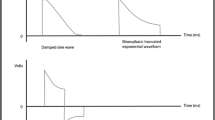Abstract
Background: The effect of general anesthesia on defibrillation efficacy in humans is not known. The purpose of this study was to determine the effect of general anesthesia on the defibrillation energy requirements in patients undergoing implantation of a pectoral defibrillator.
Methods and Results: Nineteen consecutive patients who underwent defibrillator implantation under general anesthesia were prospectively compared to 16 consecutive patients who underwent defibrillator implantation by the same physicians, using similar devices, at another hospital under conscious sedation. Pre-discharge testing was performed 1.4 ± 1.0 days after implant using sedation in both groups. The defibrillation energy requirement was determined using the same predefined step-down protocol (15, 10, 8, 5, 3, 1 J) at the time of implantation and during pre-discharge testing. The clinical characteristics of the patients were similar between groups. There was no significant difference in the mean implant defibrillation energy requirement compared to the mean pre-discharge defibrillation energy requirement in either the general anesthesia group (8.5 ± 4.7 vs. 8.4 ± 3.4 J; p = 0.9) or in the conscious sedation group (9.4 ± 3.9 vs. 9.0 ± 3.8 J; p = 0.7).
Conclusions: When compared to conscious sedation, general anesthesia with mechanical ventilation has no significant effect on defibrillation efficacy in patients undergoing defibrillator implantation.
Similar content being viewed by others
References
Strickberger SA, Hummel JD, Daoud E, et al. Implantation by electrophysiologists of 100 consecutive cardioverter defibrillators with nonthoracotomy lead systems. Circulation 1994;90:868–872.
Fitzpatrick AP, Lesh MD, Epstein LM, et al. Electrophysiological laboratory, electrophysiologist-implanted, nonthoracotomy-implantable cardioverter/defibrillators. Circulation 1994;89:2503–2508.
Pacifico A, Cedillo-Salazar FR, Nasir N Jr, et al. Conscious sedation with combined hypnotic agents for implantation of implantable cardioverter-defibrillators. J Am Coll Cardiol 1997;30:769–773.
Lipscomb KJ, Linker NJ, Fitzpatrick AP. Subpectoral implantation of a cardioverter defibrillator under local anaesthesia. Heart 1998;79:253–255.
Van Rugge FP, Savalle LH, Schalij MJ. Subcutaneous single-incision implantation of cardioverter-defibrillators under local anesthesia by electrophysiologists in the electrophysiology laboratory. Am J Cardiol 1998;81:302–305.
Keelan ET, Sra JS, Axtell K, et al. The effect of polarity of the initial phase of a biphasic shock waveform on the defibrillation threshold of pectorally implanted defibrillators. Pacing Clin Electrophysiol 1997;20:337–342.
Strickberger SA, Man KC, Daoud E, et al. Effect of firstphase polarity of biphasic shocks on defibrillation threshold with a single transvenous lead system. J Am Coll Cardiol 1995;2:1605–8.
Trappe HJ, Pfitzner P, Fain E, et al. Transvenous defibrillation leads: is there an ideal position of the defibrillation anode? Pacing Clin Electrophysiol 1997;20:880–892.
Schwartzman D, Callans DJ, Gottlieb CD, et al. Early postoperative rise in defibrillation threshold in patients with nonthoracotomy defibrillation lead systems: Attenuation with biphasic shock waveforms. J Cardiovasc Electrophysiol 1996;7:483–493.
Goldberger JJ, Horvath G, Inbar S, Kadish AH. Utility of predischarge and one-month transvenous implantable defibrillator tests. Am J Cardiol 1997;79:822–826.
Olsovsky MR, Pelini MA, Shorofsky SR, Gold MR. Temporal stability of defibrillation thresholds with an active pectoral lead system. J Cardiovasc Electrophysiol 1998;9:240–244.
Hatakeyama N, Ito Y, Momose Y. Effects of sevo_urane, iso_urane, and halothane on mechanical and electrophysiologic properties of canine myocardium. Anesthesia & Analgesia 1993;76:1327–1332.
Stowe DF, Bosnjak ZJ, Kampine JP. Comparison of etomidate, ketamine, midazolam, propofol, and thiopental on function and metabolism of isolated hearts. Anesthesia & Analgesia 1992;74:547–558.
Pharand C, Goldman R, Fan C, et al. Effect of chronic oral moricizine and intravenous epinephrine on ventricular fibrillation and defibrillation thresholds. Pacing Clini Electrophysiol 1996;9:82–89.
Von Knobelsdorff G, Goerig M, Nagele H, Scholz J. Interaction of frequency-adaptive pacemakers and anesthetic management. Discussion of current literature and two case reports. Anaesthesist 1996;45:856–860.
Cohen TJ, Lowenkron DD. The effects of pneumothorax on defibrillation thresholds during pectoral implantation of an active can implantable cardioverter defibrillator Pacing Clin Electrophysiol 1998;21:468–470.
Gill RM, Sweeney RJ, Reid PR. The defibrillation threshold: a comparison of anesthetics and measurement methods. Pacing Clin Electrophysiol 1993;16:708–714.
Babbs CF. Effect of pentobarbital anesthesia on ventricular defibrillation threshold in dogs. Am Heart J 1978;95: 331–337.
Echt DS, Black JN, Barbey JT, et al. Evaluation of antiarrhythmic drugs on defibrillation energy requirements in dogs. Circulation 1989;79:1106–1117.
Natale A, Jones DL, Kim Y-H, Klein GJ. Effects of lidocaine on defibrillation threshold in the pig: evidence of anesthesia related increase. Pacing Clin Electrophysiol 1991;14: 1239–44.
Dorian P, Fain ES, Davy J-M, Winkle RA. Lidocaine causes a reversible, concentration-dependent increase in defibrillation energy requirements. J Am Coll Cardiol 1986;8: 327–332.
Ujhelyi MR, Sims JJ, Miller AW. High-dose lidocaine does not affect defibrillation efficacy: implications for defibrillation mechanisms. Am J Physiology1998;274:H1113–1120.
Echt DS, Gremillion ST, Lee JT, et al. Effects of procainamide and lidocaine on defibrillation energy requirements in patients receiving implantable cardioverter defibrillator devices. J Cardiovasc Electrophysiol 1994;5:752–760.
Nelson SD, Lenhart MB, Saffarin A. The influence of sodium channel blockade on the defibrillation energy requirements of biphasic versus monophasic shocks. Pacing Clin Electrophysiol 1996;19:1568–1573.
Winecoff-Miller AP, Sims JJ, McSwain R, Ujhelyi MR. Lidocaine' effect on defibrillation threshold are dependent on the defibrillation electrode system: Epicardial versus endocardial. J Cardiovasc Electrophysiol 1998;9:312–320.
Horton RP, Canby RC, Roman CA, et al. Determinants of nonthoracotomy biphasic defibrillation. PACE 1997;20: 60–64.
Author information
Authors and Affiliations
Rights and permissions
About this article
Cite this article
Knight, B.P., Pelosi, F., Flemming, M. et al. Effect of General Anesthesia on the Defibrillation Energy Requirement in Patients Undergoing Defibrillator Implantation. J Interv Card Electrophysiol 3, 325–328 (1999). https://doi.org/10.1023/A:1009831802964
Issue Date:
DOI: https://doi.org/10.1023/A:1009831802964



